Playing Possum: 9 Animals That Play Dead to Survive
Thanatosis or tonic immobility is the term used to describe the tactic of playing dead that certain species of animals use for various purposes. Some will play dead to lure in potential prey, and others play dead when faced with a lethal threat themselves. In this article, we’ll discuss nine animals that play dead to survive contact with a predator, and these animals all have a unique twist.
#9 Virginia Opossum

The Virginia opossum (Didelphis virginiana) is the creature that the hallmark phrase playing possum is based on. This animal is the only marsupial native to the United States and Canada, and they are frequently referred to as possums even though they belong to a completely different genus. Also known as the North American opossum, these cousins of kangaroos put a considerable amount of effort into their playacting.
When threatened by a bobcat or other predator, opossums will throw themselves onto their backs, bare their teeth, drool saliva out of their mouths, and excrete an extremely foul-smelling liquid from their anal glands all in an attempt to escape mortal danger. These actions frequently cause people to suspect that the opossum may be suffering from rabies, but in fact, they are just a natural defense mechanism. Opossums are also scavengers, and this behavior can be life-threatening when they are frightened by cars while investigating roadkill, and play dead in the middle of the road.
#8 Texas Indigo Snake

Joe Farah/Shutterstock.com
Texas indigo snakes (Drymarchon melanurus erebennus) are a subspecies of the eastern indigo snake, and they have been known to play dead as well. These snakes can grow up to 7 feet long and are found throughout Texas. They are not venomous nor are they constrictors, and they have to rely on their muscular jaws to overpower and swallow their meals head first. Texas indigo snakes even hunt venomous rattlesnakes and are immune to their venom.
When threatened, these large snakes have been recorded loosely coiling their bodies and becoming immobile. They even part their jaws to give a slackened appearance. If they are manipulated by hand during this thanatosis, then they will rotate their bodies to remain belly down but will otherwise remain still.
#7 Ducks

Many species of ducks will feign death when facing perceived dangers to include those as well known as the North American wood duck (Aix sponsa) and the mallard (Anas platyrhynchos). Researchers have documented that 29 out of 50 different wild ducks played dead when exposed to captive red foxes. This immediate collapse at least gives the duck a fighting chance should the fox lower its guard.
It was also discovered that the ducks would remain still for long enough to even be brought back to the fox’s den in an attempt to escape later. Veteran foxes quickly learned that they needed to inflict fatal or crippling injuries even on ducks that appeared to be dead due to the prevalence of thanatosis among the species.
#6 Lemon Shark
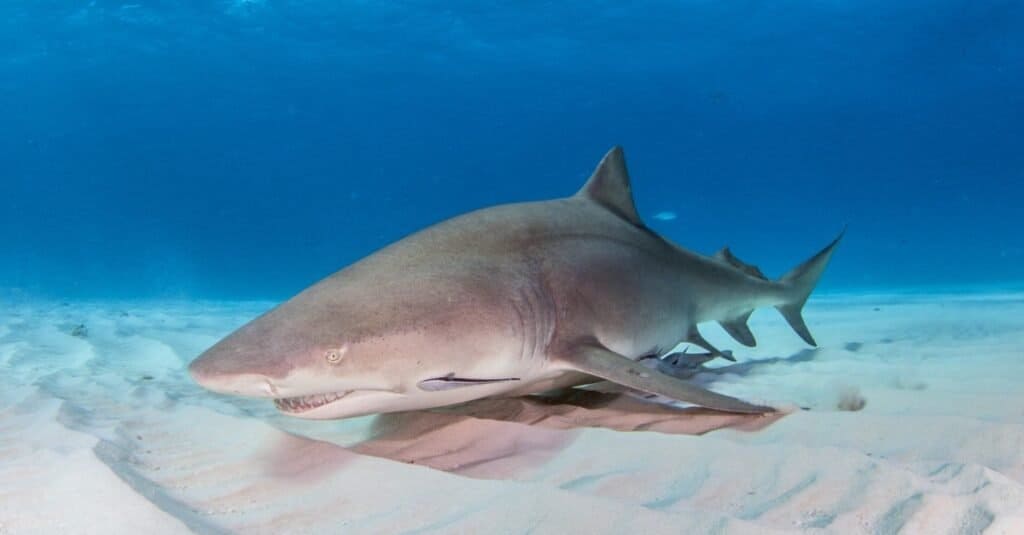
The lemon shark (Negaprion brevirostris) is interesting in that it is an apex predator and yet is one of the animals that play dead. If the lemon shark is turned onto its back, then it will not only play possum but also begin to exhibit labored breathing and the occasional tremor. This is especially interesting when considering that the lemon shark is known to lay on the ocean floor and allow other animals to pick the parasites off its body. They have the ability to remain completely still and pump water over their gills to breathe.
Lemon sharks prey upon many types of fish, stingrays, and even other sharks. The fact that they also use tonic immobility is striking since they do not have contact with significant natural predators. However, they also are far from the only species of shark to exhibit tonic immobility.
#5 Rabbits
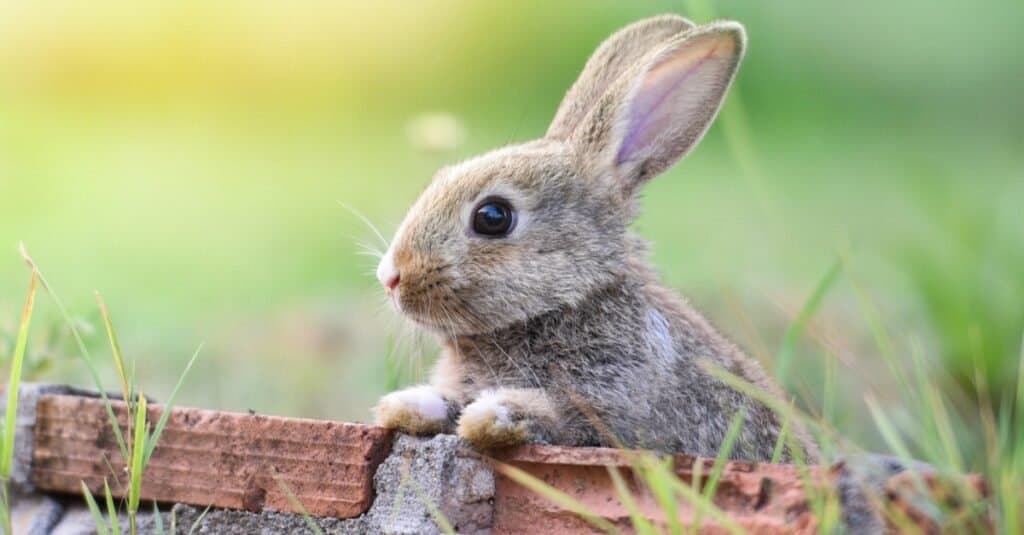
Both domesticated rabbits and those in the wild have exhibited thanatosis, but this is not entirely surprising considering their status as prey animals. Domesticated rabbits that are used as pets (Oryctolagus cuniculus) are sometimes put into a trance by their owners. This capitalizes upon the rabbit’s natural self-preservation instinct as something that gives the appearance of affection or relaxation.
In reality, rabbits spend most of their time with the majority of their paws on the ground. If they are placed into a position where they feel unable to flee, then they will display tonic immobility as a defense. What is believed to be a form of hypnosis is actually an extension of their natural fight or flight reflex and can even be stressful on the animal. Researchers have confirmed this stress by monitoring rabbits’ heart rates and respirations while in this condition.
#4 Pygmy Grasshopper
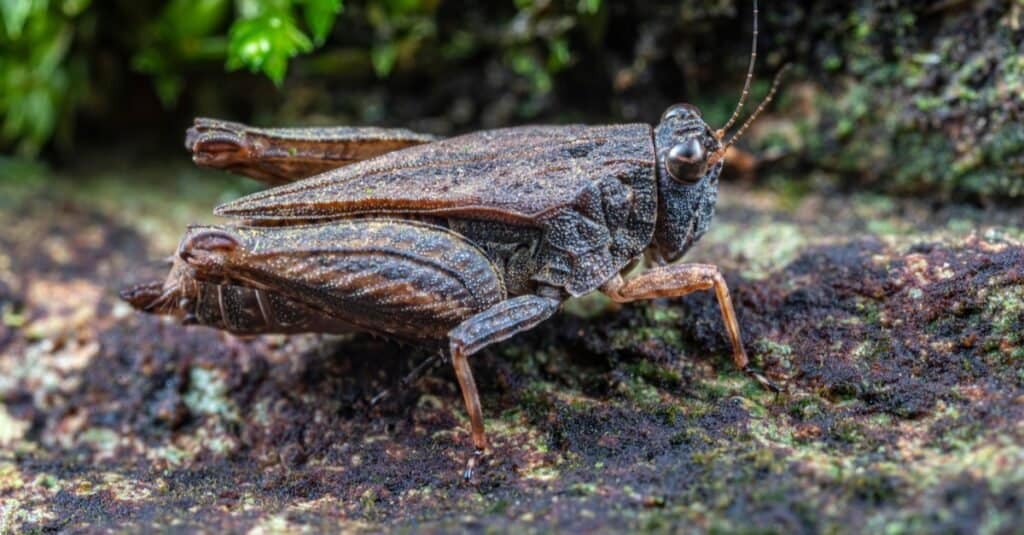
Peter Yeeles/Shutterstock.com
The pygmy grasshopper (Criotettix japonicus) has displayed a unique version of playing possum when faced with danger. They completely freeze just like the other members of our list, but in addition, they also splay their legs out as far as possible in all directions and make them stiff. That makes it nearly impossible for the predatory frogs to even attempt to swallow them.
These grasshoppers are native to Japan, and this individualized approach to death feigning fits perfectly in with the threats that they are most likely to face. Predation by so-called sit and wait hunters would leave the grasshopper vulnerable if they just simply played dead without the additional hurdle of extending all of their body parts in every possible direction. This prevents the frog from swallowing them immediately and greatly increases the chance that the grasshopper will survive.
#3 Redback Spider

The redback spider (Latrodectus hasselti) is a close cousin of the black widow spider, and they are equally deadly to humans. Thankfully, these spiders are not aggressive towards humans, so the majority of the bites are when the spiders are trapped between clothing or shoes and skin. The redback has also been known to be more much more aggressive when defending its eggs. Both sexes of the spider bite at equal rates, but the female is responsible for far more instances of the victim receiving a dose of venom.
Given its more docile nature, it may not come as a surprise that this spider is more likely to respond with tonic immobility when it senses danger outside of its web. Redback spiders are one of the animals that play dead and will curl into a ball and remain completely frozen in place. These spiders are native to Australia but have migrated to New Zealand, Japan, and several other countries through fruit imports.
#2 Eastern Hognose Snake
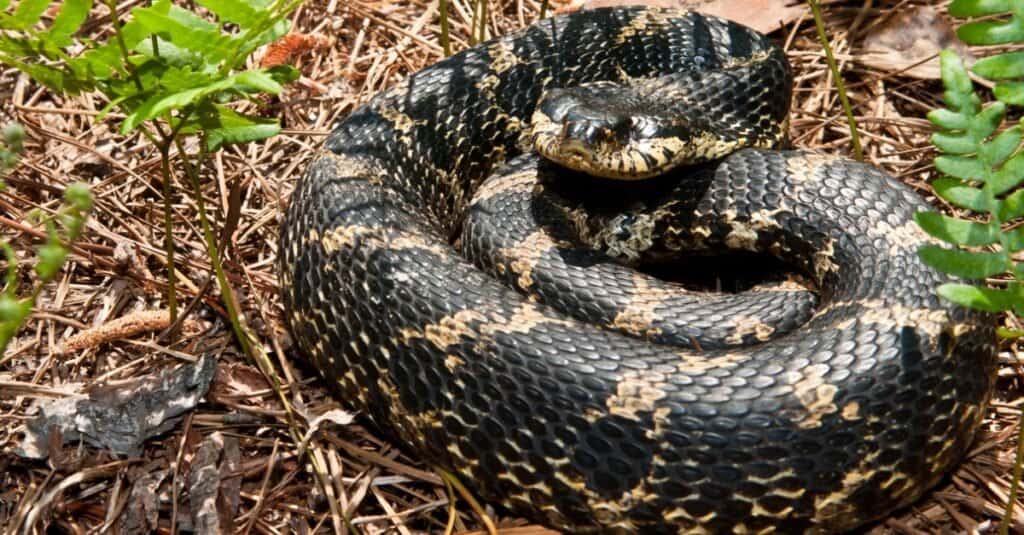
The eastern hognose snake (Heterodon platirhinos) is the second snake to make our list, and this one does a much better job of selling the act. Hognose snakes are found throughout the world with all of them performing thanatosis. The eastern hognose primarily resides in the Eastern half of the United States and prefers woodland environments.
Although they grow to lengths of up to 46 inches, these snakes put on quite the show when faced with what they believe is dangerous. The eastern hognose snake first begins to writhe back and forth as if it were in pain while at the same time excreting an extremely foul odor. After some time, the snake collapses onto its back with its jaws slightly parted and lays there unmoving. It will remain in this state for some time even if you were to prod or handle it.
#1 Antlion
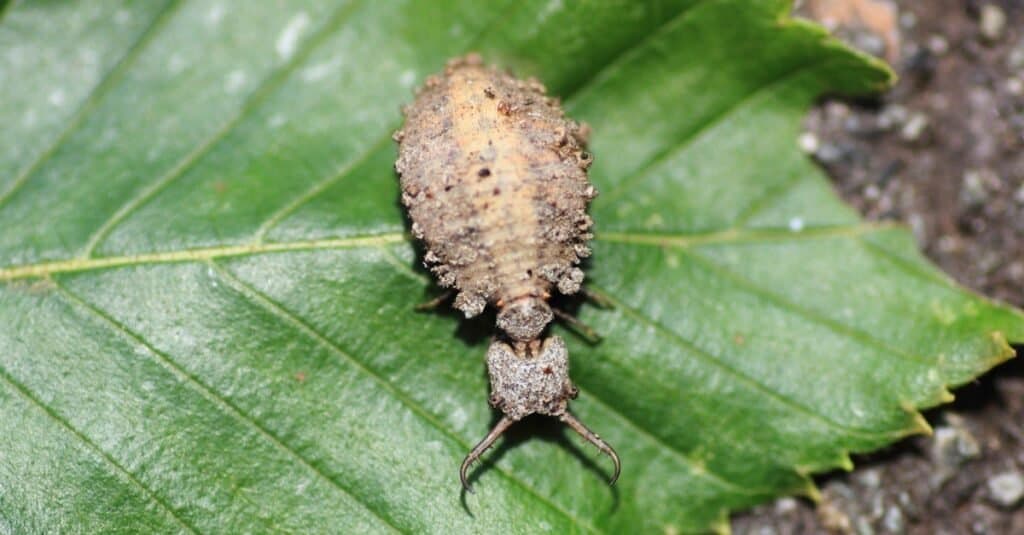
Antlions are insects that are known for their extremely aggressive and predatory larva and their equally impressive possum playing. With a literal myriad of species that can be referred to by that name, we are specifically speaking about Euroleon nostras. This antlion was recorded by researchers having played possum for 61 minutes. All antlion species feign death, but that level of commitment to the tactic deserves a mention of its own.
Called doodlebugs in the United States, antlion larva is ambush predators that attack from pits or hiding places and suck the insides of their victims out. These larvae are so aggressive because they need to consume enough food to sustain the adult evolution of the species as they don’t eat once their transformation is complete.
There are such a wide variety of animals that play dead when facing danger that this list just scratches the surface. The vast majority of insects experience tonic immobility in some fashion, and there is another entire group of wild animals that plays possum for other reasons such as to hunt or mate more effectively.
More from A-Z Animals
Thanatosis or tonic immobility is the term used to describe the tactic of playing dead that certain species of animals use for various purposes. Some will play dead to lure in potential prey, and others play dead when faced with a lethal threat themselves. In this article, we’ll discuss nine animals that play dead to survive contact with a predator, and these animals all have a unique twist.
#9 Virginia Opossum

The Virginia opossum (Didelphis virginiana) is the creature that the hallmark phrase playing possum is based on. This animal is the only marsupial native to the United States and Canada, and they are frequently referred to as possums even though they belong to a completely different genus. Also known as the North American opossum, these cousins of kangaroos put a considerable amount of effort into their playacting.
When threatened by a bobcat or other predator, opossums will throw themselves onto their backs, bare their teeth, drool saliva out of their mouths, and excrete an extremely foul-smelling liquid from their anal glands all in an attempt to escape mortal danger. These actions frequently cause people to suspect that the opossum may be suffering from rabies, but in fact, they are just a natural defense mechanism. Opossums are also scavengers, and this behavior can be life-threatening when they are frightened by cars while investigating roadkill, and play dead in the middle of the road.
#8 Texas Indigo Snake

Joe Farah/Shutterstock.com
Texas indigo snakes (Drymarchon melanurus erebennus) are a subspecies of the eastern indigo snake, and they have been known to play dead as well. These snakes can grow up to 7 feet long and are found throughout Texas. They are not venomous nor are they constrictors, and they have to rely on their muscular jaws to overpower and swallow their meals head first. Texas indigo snakes even hunt venomous rattlesnakes and are immune to their venom.
When threatened, these large snakes have been recorded loosely coiling their bodies and becoming immobile. They even part their jaws to give a slackened appearance. If they are manipulated by hand during this thanatosis, then they will rotate their bodies to remain belly down but will otherwise remain still.
#7 Ducks

Many species of ducks will feign death when facing perceived dangers to include those as well known as the North American wood duck (Aix sponsa) and the mallard (Anas platyrhynchos). Researchers have documented that 29 out of 50 different wild ducks played dead when exposed to captive red foxes. This immediate collapse at least gives the duck a fighting chance should the fox lower its guard.
It was also discovered that the ducks would remain still for long enough to even be brought back to the fox’s den in an attempt to escape later. Veteran foxes quickly learned that they needed to inflict fatal or crippling injuries even on ducks that appeared to be dead due to the prevalence of thanatosis among the species.
#6 Lemon Shark

The lemon shark (Negaprion brevirostris) is interesting in that it is an apex predator and yet is one of the animals that play dead. If the lemon shark is turned onto its back, then it will not only play possum but also begin to exhibit labored breathing and the occasional tremor. This is especially interesting when considering that the lemon shark is known to lay on the ocean floor and allow other animals to pick the parasites off its body. They have the ability to remain completely still and pump water over their gills to breathe.
Lemon sharks prey upon many types of fish, stingrays, and even other sharks. The fact that they also use tonic immobility is striking since they do not have contact with significant natural predators. However, they also are far from the only species of shark to exhibit tonic immobility.
#5 Rabbits

Both domesticated rabbits and those in the wild have exhibited thanatosis, but this is not entirely surprising considering their status as prey animals. Domesticated rabbits that are used as pets (Oryctolagus cuniculus) are sometimes put into a trance by their owners. This capitalizes upon the rabbit’s natural self-preservation instinct as something that gives the appearance of affection or relaxation.
In reality, rabbits spend most of their time with the majority of their paws on the ground. If they are placed into a position where they feel unable to flee, then they will display tonic immobility as a defense. What is believed to be a form of hypnosis is actually an extension of their natural fight or flight reflex and can even be stressful on the animal. Researchers have confirmed this stress by monitoring rabbits’ heart rates and respirations while in this condition.
#4 Pygmy Grasshopper

Peter Yeeles/Shutterstock.com
The pygmy grasshopper (Criotettix japonicus) has displayed a unique version of playing possum when faced with danger. They completely freeze just like the other members of our list, but in addition, they also splay their legs out as far as possible in all directions and make them stiff. That makes it nearly impossible for the predatory frogs to even attempt to swallow them.
These grasshoppers are native to Japan, and this individualized approach to death feigning fits perfectly in with the threats that they are most likely to face. Predation by so-called sit and wait hunters would leave the grasshopper vulnerable if they just simply played dead without the additional hurdle of extending all of their body parts in every possible direction. This prevents the frog from swallowing them immediately and greatly increases the chance that the grasshopper will survive.
#3 Redback Spider

The redback spider (Latrodectus hasselti) is a close cousin of the black widow spider, and they are equally deadly to humans. Thankfully, these spiders are not aggressive towards humans, so the majority of the bites are when the spiders are trapped between clothing or shoes and skin. The redback has also been known to be more much more aggressive when defending its eggs. Both sexes of the spider bite at equal rates, but the female is responsible for far more instances of the victim receiving a dose of venom.
Given its more docile nature, it may not come as a surprise that this spider is more likely to respond with tonic immobility when it senses danger outside of its web. Redback spiders are one of the animals that play dead and will curl into a ball and remain completely frozen in place. These spiders are native to Australia but have migrated to New Zealand, Japan, and several other countries through fruit imports.
#2 Eastern Hognose Snake

The eastern hognose snake (Heterodon platirhinos) is the second snake to make our list, and this one does a much better job of selling the act. Hognose snakes are found throughout the world with all of them performing thanatosis. The eastern hognose primarily resides in the Eastern half of the United States and prefers woodland environments.
Although they grow to lengths of up to 46 inches, these snakes put on quite the show when faced with what they believe is dangerous. The eastern hognose snake first begins to writhe back and forth as if it were in pain while at the same time excreting an extremely foul odor. After some time, the snake collapses onto its back with its jaws slightly parted and lays there unmoving. It will remain in this state for some time even if you were to prod or handle it.
#1 Antlion

Antlions are insects that are known for their extremely aggressive and predatory larva and their equally impressive possum playing. With a literal myriad of species that can be referred to by that name, we are specifically speaking about Euroleon nostras. This antlion was recorded by researchers having played possum for 61 minutes. All antlion species feign death, but that level of commitment to the tactic deserves a mention of its own.
Called doodlebugs in the United States, antlion larva is ambush predators that attack from pits or hiding places and suck the insides of their victims out. These larvae are so aggressive because they need to consume enough food to sustain the adult evolution of the species as they don’t eat once their transformation is complete.
There are such a wide variety of animals that play dead when facing danger that this list just scratches the surface. The vast majority of insects experience tonic immobility in some fashion, and there is another entire group of wild animals that plays possum for other reasons such as to hunt or mate more effectively.






